Playing with surface expressions at Peach Corner
Our first stop is Peach Corner in Frederiksberg, which is showing the exhibition Fictions with ceramic art by Carlo Lorenzetti and Carl Emil Jacobsen.
The artist-run ceramic gallery recently celebrated its one-year anniversary, and Karen Kitani Harsbo, who runs the venue together with eight other ceramicists is excited to note that Peach Corner has established a good connection with its core audience of ceramics enthusiasts.
Our first impression is that of a small but inviting exhibition of mutually very different works. Their varying surfaces and artistic expressions invite a discussion about surface textures, materiality and the immediate associations sparked by the viewer’s encounter with the works.
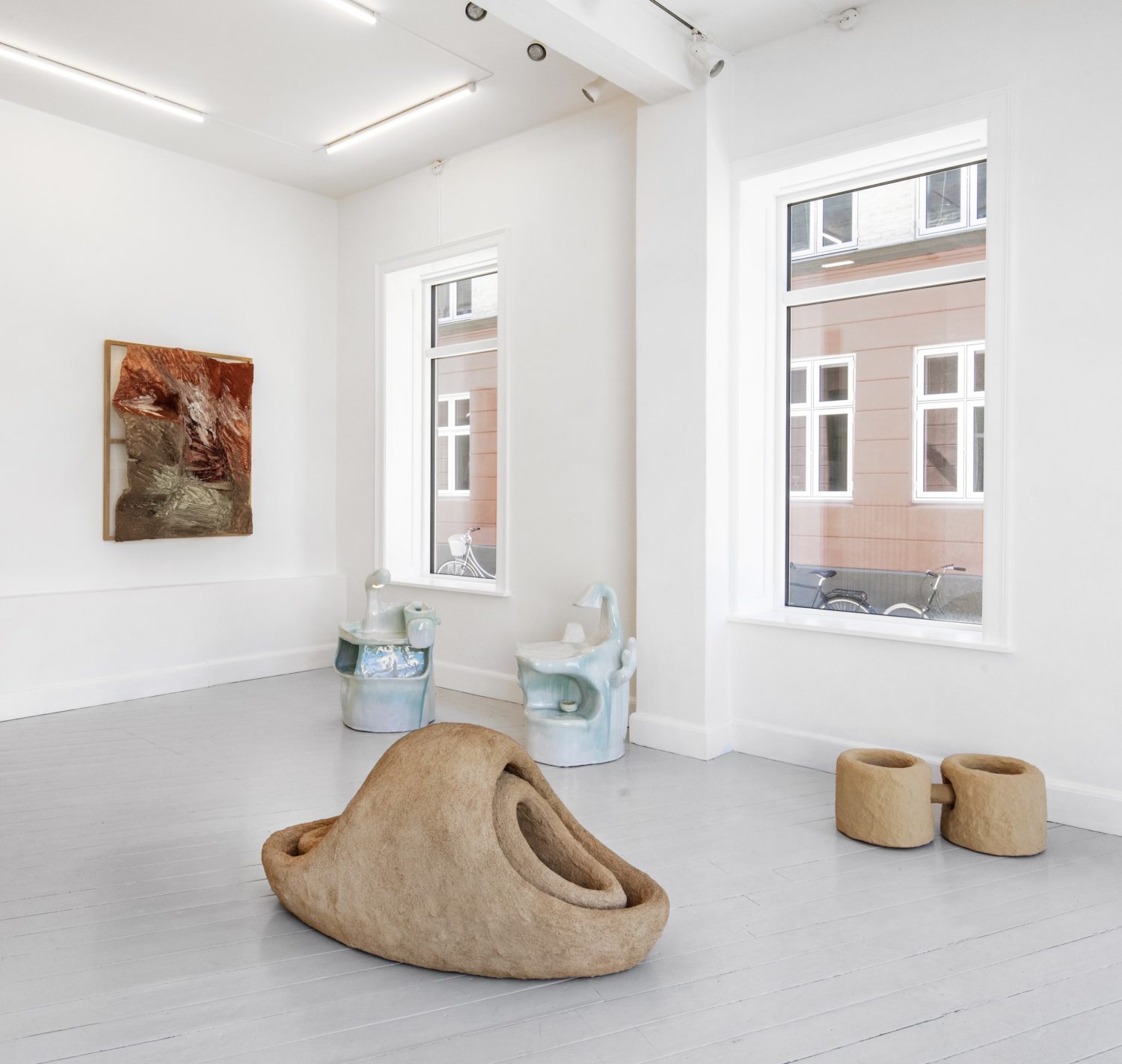
Hung on the walls of the gallery are three reliefs by Carl Emil Jacobsen, who also presents two sculptural objects: Ochre Powder Variation #3 and Ochre Powder Variation #5. All his works are in muted earth tones produced by placing different oxides (iron, ochre, umber and copper) in polystyrene moulds in layers of varying thickness and then casting them in fibre concrete. The two sculptural objects on the floor are beautifully finished organic shapes with the same rough surface texture. The matt, sandpaper-like surface absorbs the light, and the shapes resemble body cavities, tissue and joints.
Carlo Lorenzetti’s four sculptural objects Bedside 1–4 also have an organic expression. They invite the viewer into a Flintstone Family universe with rounded ceramic bedside tables complete with drawers, shelves and lighting. Functional in appearance yet impractical.
The objects invite interaction. They are fairly short of stature, making it necessary to squat down in order to peer through the apertures. As design student Selma comments, ‘
You’re not quite sure what perspective to adopt, since it makes sense both to crouch down and to look at the works from above. The forms are unpredictable.’
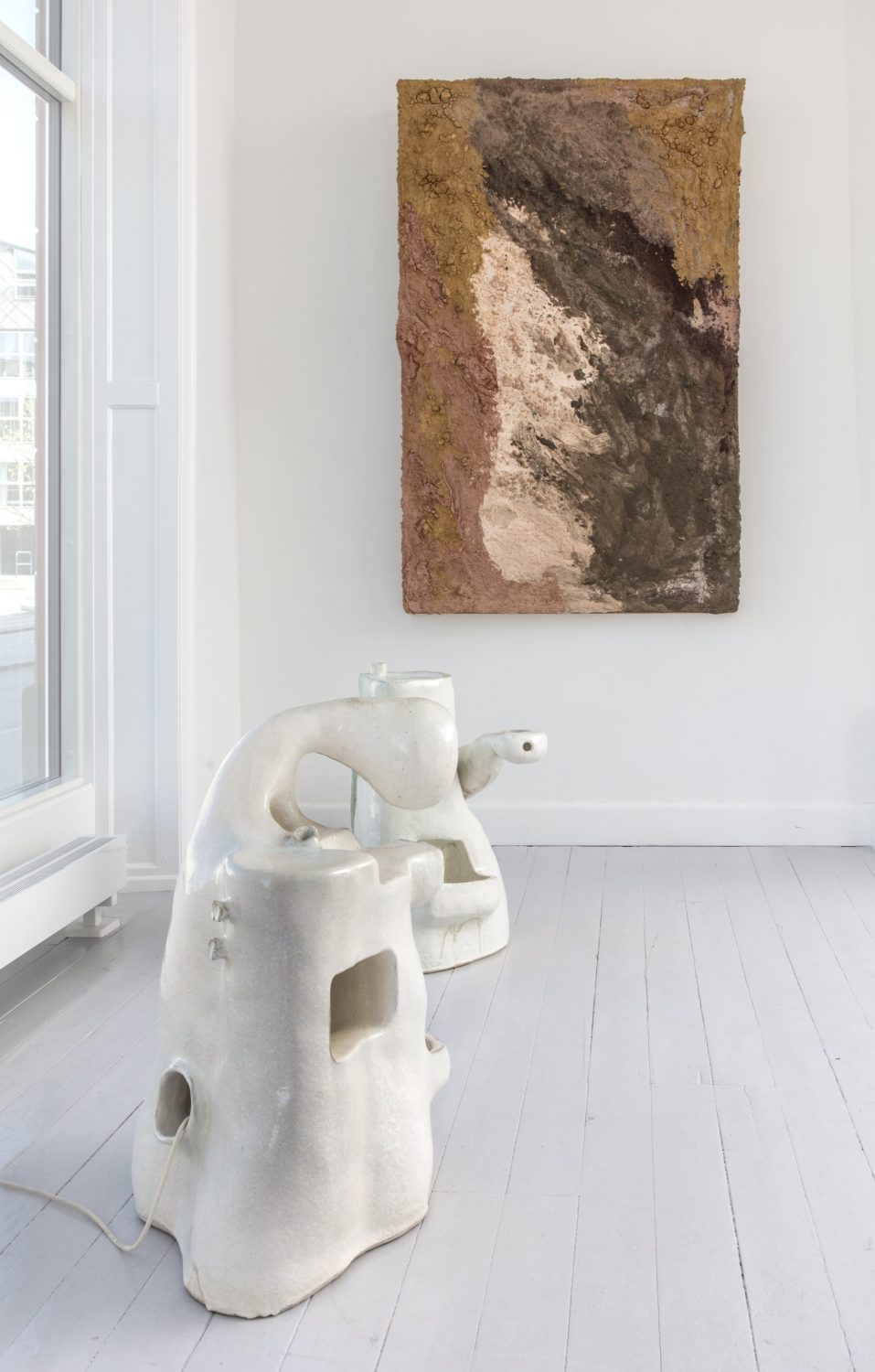
The juxtaposition of the two artists’ works highlights their differences and similarities. The playful treatment of utilitarian function is obvious in Lorenzetti’s work, while Jacobsen’s expression is more purely sculptural. Both ceramic artists have a strong focus on surface textures. It is tempting to run a hand over Lorenzetti’s sculptures, whose smooth, glazed surface reflects the light, while the matt, sandpapery surface of Jacobsen’s pieces do not have the same tactile appeal.
Fictions was curated by Kristine Tillge Lund and is a perfect match for Peach Corner’s ambition of staging exhibitions that are both ambitious and experimental. It is not an exhibition that can be appreciated in a brief glance. The nuances in the two artists’ very different approaches reveal themselves gradually, as the viewer takes the time to explore their own sensuous impressions in the encounter with the objects.
Textile variation at Udstillingssted for Tekstil
Our next destination is Udstillingssted for Tekstil (Exhibition Venue for Textile) and the new exhibition Blooomingtooon with works by textile artists Jette Hartvig, Anita Bracalente and Isabel Berglund.
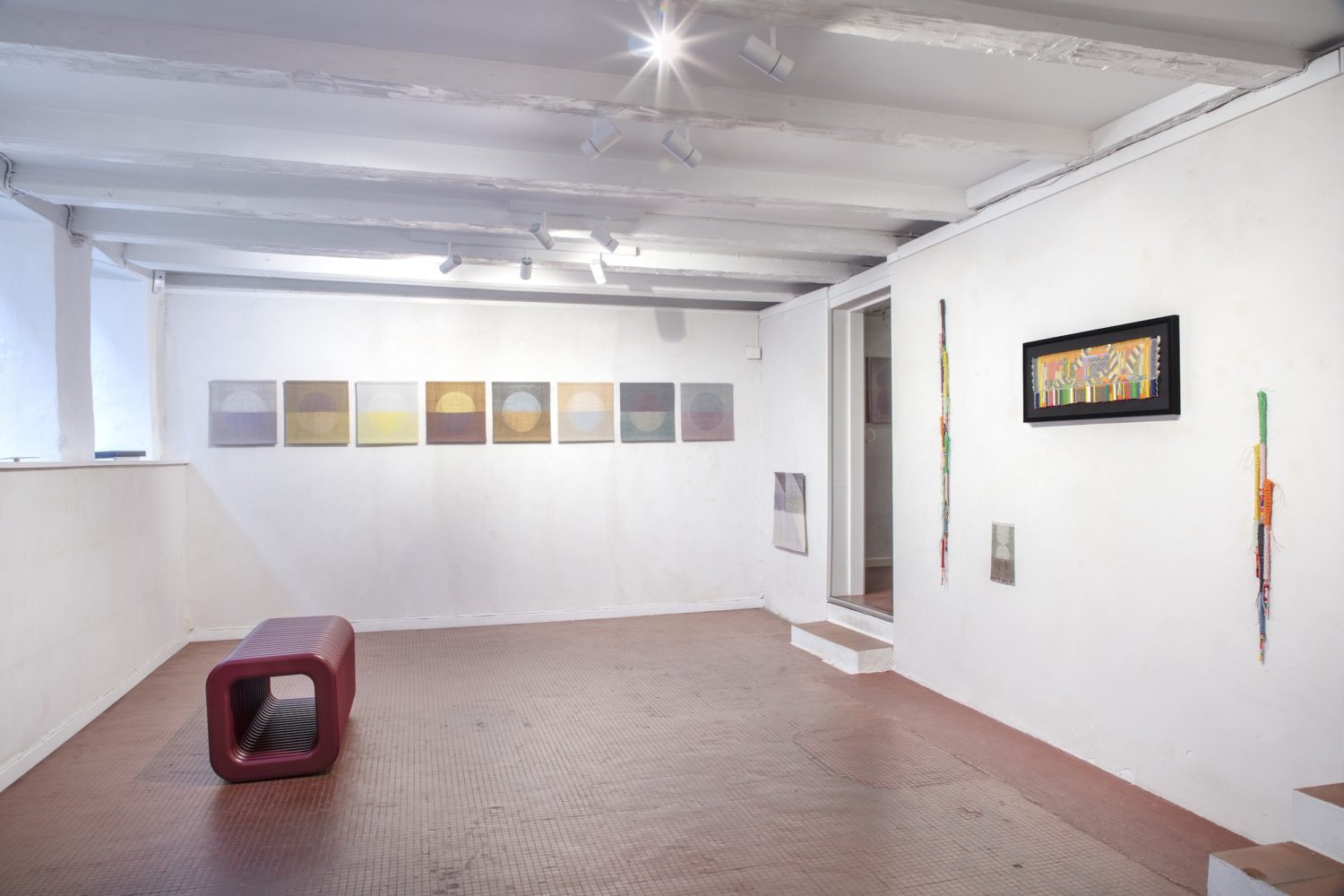
The kinship among the works of the three artists is immediately apparent in the pixelation of both knit and woven pieces. However, Jette Hartvig’s textiles stand out slightly because they represent a more delicate colourism in a weave with a warp made of paper strips in watercolour tones and weft in light-coloured linen or cotton.
Hartvig is represented by several woven pieces, including the eight-part Blodmåne (Blood Moon) from 2015.
As in several of her other pieces, she has overtightened the weft; an intentional ‘flaw’ that results in delicate variations in colour tone. Her works spark associations to both landscapes and mirror reflections.
It is bold to apply such an understated approach in both scale and colour range.
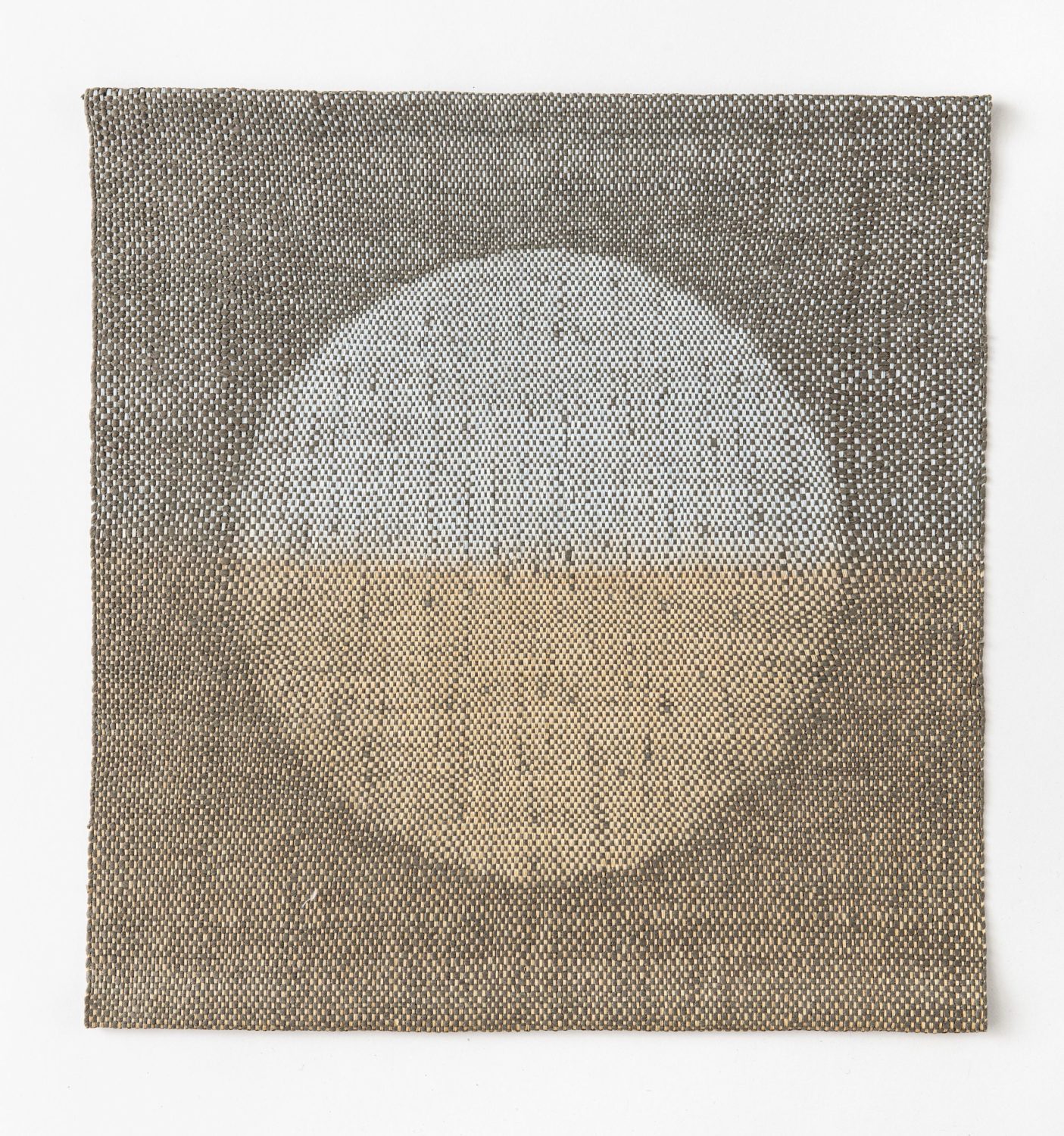
Isabel Berglund’s and Anita Bracalente’s exhibits have more powerful colour statements. Isabel Berglund covers found objects in knitting, for example her surreal object Table Pet (2016), a console table wrapped in thick, black knitting, or her Soft Arrow (2020) group featuring Berglund’s own paint stirring sticks covered in knitting in bright colours.
Anita Bracalente’s hand-knitted pieces with countless tiny glass beads, spark associations to both art deco interiors, patchwork, fractal patterns and Islamic rugs. Initially, the patterns seem reassuringly familiar, but on closer inspection they break up, and the delicate order is deconstructed.
An excellent and intimate little exhibition that demonstrates the wide range of the textile craft.
Coherent total installation at Officinet
At Officient, the design studio Ahm&Lund – furniture designer Isabel Ahm and cabinet maker Signe Lund – has created an exhibition, or perhaps rather a total installation, titled Symposium.

We meet Signe Lund in the exhibition. She offers an engaged introduction to the exhibits, all of which are characterized as ‘prototypes’, a term that aptly underscores the exhibition’s position somewhere between art and function.
The event programme of Symposium, which includes contributions from an eco-theologian, an actor and a watchmaker, aims to generate dialogue between different disciplines and is based on the beautiful and unusual piece Moonwork (2021): a black basalt clock with a dome pinched in black clay and Parian porcelain.
The clock does not count the hours but instead depicts the moon’s journey from new moon to full moon and back to the new moon, measured in the slow movement of the light across the matt white dome.
Signe explains that the clock thus ‘relates to a different time than the familiar 24-hour cycle, where we’re always planning what to do tomorrow. We need to remember that there is a moon orbiting around the earth and how humankind is connected to a much larger system.’
An interesting thought and illustration of the fact that there are other ways to structure time than the one we commonly rely on. We note the quiet, rhythmic ticking of the clock’s mechanical works. A nostalgic sound that brings up memories from the past and mixes with the soundscape created by the Danish musician Niels Hulgård that is playing softly in background.
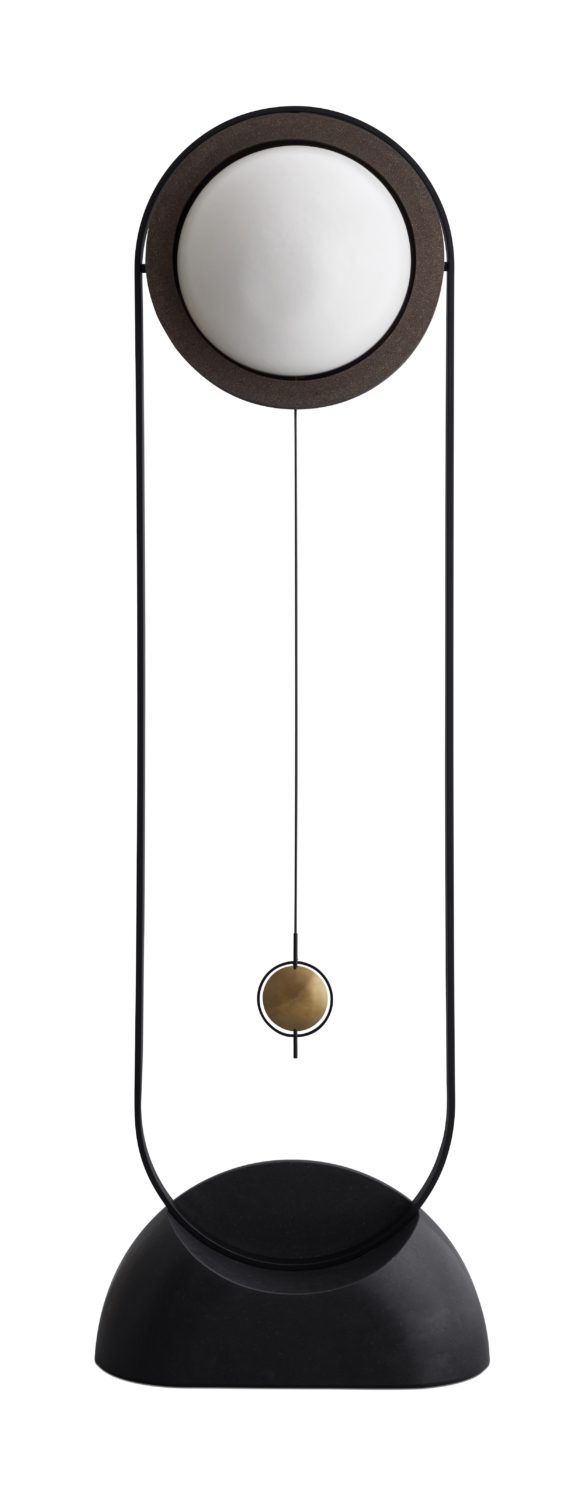
Sustainable choices are a common theme in all the exhibits, and the processes that went into their development and crafting are relayed through small models and material samples. For example, the wooden furniture pieces in the Apart series (2021–22) are knock-down designs, meaning they can be disassembled and packed flat, and they have eelgrass padding instead of foam. The eelgrass comes from meadows on the island of Læsø and is both durable, fire-retardant and hygroscopic. The latter feature means that it is capable of absorbing and releasing humidity from and to the environment, which promotes a good indoor climate.
Symposium is a coherent exhibition with elements of sound, tone-on-tone colours, thought-provoking content and minimalist hand-crafted furniture that are a good match for the setting at Officinet.
The colour comes from inside at Bygning A
We round off our day with a visit to the exhibition The colour comes from inside at Bygning A, which shows works by Danish textile artist Louise Sass created from 1989 to 2021.
The exhibition opens with a running tap. The water runs into a steel sink with traces of surplus dye. That sets the stage. The focus here is on textile craft. Next to the sink is a printing table, which shows a projected film of Louise Sass seen from above while she is printing at a table in the same format. An excellent didactic device to inspire the audience to delve into and reflect on the essence of the exhibition theme, whether they are new to the field or knowledgeable about textile printing. We see the hands at work, releasing the wondrous magic of colour. From this opening scene we are ready to move on in our tour of Louise Sass’s colour studies.
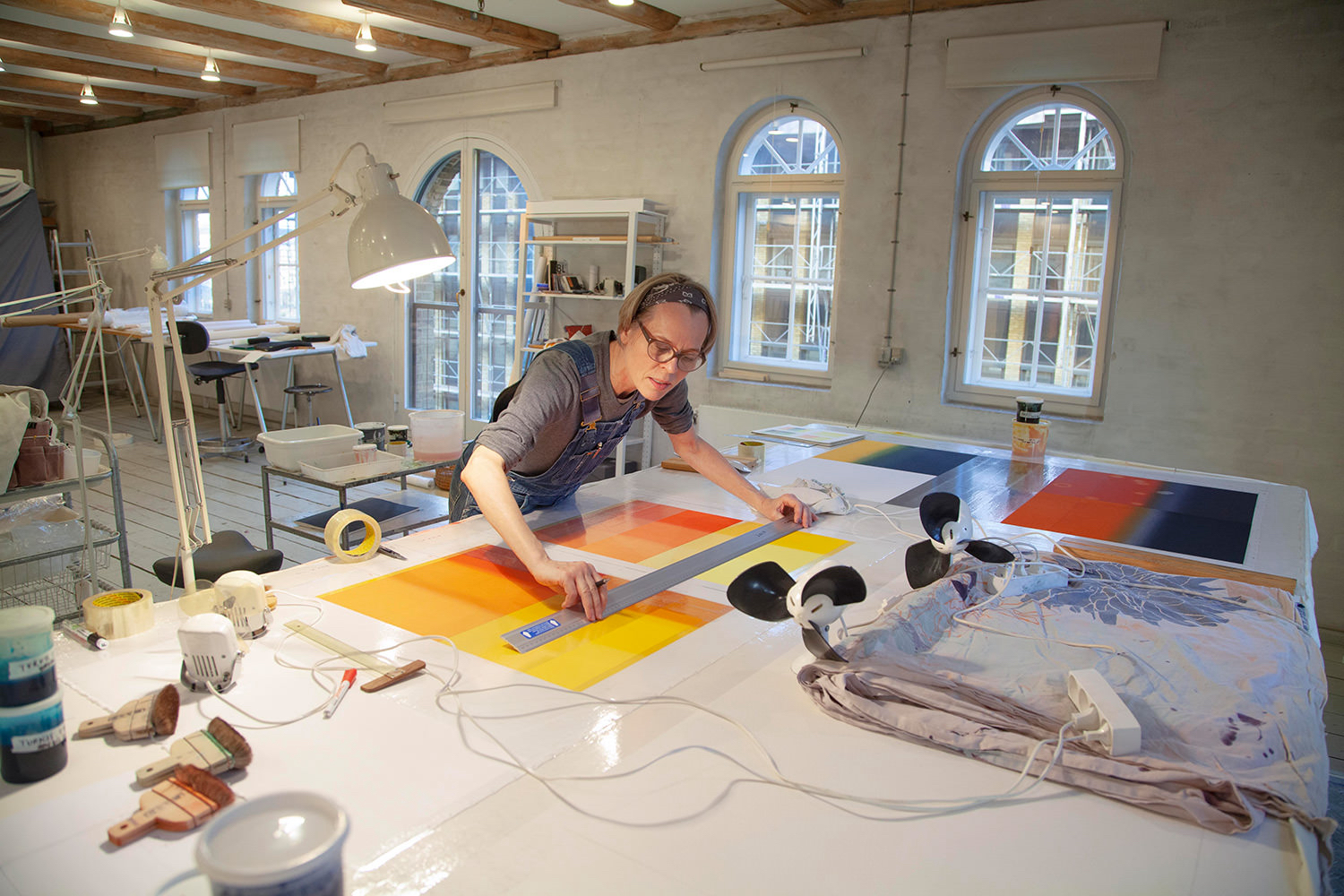
The exhibition has several recurring features in addition to the colour theme: patterns repeated in different variations and lengths of textile folded and hung on the wall in a presentation that gives the flat textiles a three-dimensional effect.
Throughout the exhibition, we repeatedly encounter pieces that make us curious about the process. Just as we are looking at Ingen skal sige #2 (No one should say #2) (2001) and debating the printing technique, we are fortunate enough to bump into Louise Sass.
She explains how she used a chemical resist print in this piece, a technique she used frequently until 2002. (The technique is now obsolete, because this type of reactive dye and the chemical substances it requires are no longer produced).
‘This rather unique textile print was made with an initial chemical resist print in graduated notes of grey, violet and red, a so-called iris print. Next, I superimposed additional prints in displaced layers with a different type of reactive dye in black, grey, pink and violet. Interestingly, when the fabric has been steamed and washed, the first print appears to be the top layer, while the contours of the superimposed prints are only glimpsed as faint shadows inside the rounded shapes.’ – Louise Sass

We also have a talk with Louise Sass about studies versus finished pieces.
‘Prior to the finished pieces I carry out numerous studies and trial prints. Some pieces lie around for years before they are mounted and presented as finished pieces or shown in a new context.’ – Louise Sass.
Thus, Louise Sass’s production can be seen both as one long trial or study and as a work series.
It is a coherent exhibition with a consistent theme throughout. Rooms and dividing walls are clean and white, letting the colours play the lead role. We find that being confronted with this intense colour experience causes us to reflect on the colours outside the windows. The crisp green leaves on the chestnut trees, the way a blue shipping container affects the colour of the white bulk container next to it.
The exhibition The colour comes from inside can thus be appreciated at several different levels, including simply as an aesthetic encounter with the beauty of the many colours.
4x udstillinger
Fictions. Carlo Lorenzetti (US/NL) and Carl Emil Jacobsen (DK).
21 April – 28 May 2022
Peach Corner. Howitzvej 67A, ground floor, left, 2000 Frederiksberg
Blooomingtooon. Isabel Berglund (DK), Anita Bracalente (Bloomington, US), Jette Hartvig (DK).
29 April – 18 June 2022.
Udstillingssted for Tekstil. Møntergade 6, 1116 Copenhagen K
SYMPOSIUM: An exhibition by design duo Ahm&Lund. Isabel Ahm (DK), Signe Lund (DK).
28 April – 6 May 2022
Officinet. Bredgade 66, 1260 Copenhagen K
The colour comes from inside. Louise Sass (DK)
28 April – 28 August 2022.
Bygning A. Kløvermarksvej 70, 2300 Copenhagen S
All four exhibitions have a strong emphasis on materiality and craftsmanship across different disciplines and media.
The boundaries between art, crafts and design are fluid and reflect a strong focus on exploring and reflecting on the choice of materials and techniques as well as a desire to make an impact through the exhibited works.


